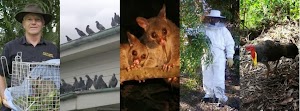Every few months we have a customer who has mysterious bites or points of intense irritation that look like bites. Usually their house has been stripped, vacuumed and cleaned several times and the property has been sprayed for “insects”. Since the “bites” have continued, we are asked to treat and remove suspected “bird lice”.
It is true that bird lice will bite humans causing tiny red spots and the lice themselves are very small (smaller than a pin head) and so they are very hard to see. Bird lice may be the cause but there are other possibilities including other small insects, allergies to pollens floating in the air, plant sap, plant seeds and other airborne particles from plants.
The first step is to establish whether there is any reason why bird lice might be the source of the problem. If there is some evidence of birds nesting or roosting inside the roof or perhaps in the gutters, then the lice may have moved down into the rooms of the property. This usually only happens in summer and autumn and the trigger for a problem is most likely to be the departure of the young birds from a nest, when they are able to fly. Then the lice suddenly find they have nothing to feed on and they move away from the nest looking for a new host: something warm to bite. So there can be a sudden exodus of many lice, coming into a room through gaps in the wall or blown through the open window. Fortunately, bird lice cannot survive on people because our body temperature is not high enough, but they do produce eggs which will lie in the nest material for a long time waiting for another bird to come nearby, at which time they hatch out looking for a feed.
The most likely species of bird in Brisbane to cause problems are pigeons, indian mynas and (much more unusual in recent times) sparrows. All these species have untidy, messy nests.
The critical issue is that a few birds sleeping on or in a building are very unlikely to give the human occupants a problem with lice. The lice will stay on the bird or its immediate nesting spot. Problems usually only occur when the birds finish nesting and many lice have developed while the baby birds were in the nest.
In cases where bird lice are known to be the problem (because of close proximity to pigeon nests), all the bites on people were found in the warmer sweaty areas, in folds of skin and underneath tight clothing, with very few bites on the exposed skin of face or arms. This observation agrees with the idea the bird lice are primarily looking for “hot spots”.
Bird lice die quickly if there is no bird host and they are very easy to kill with insecticides. Persistent problems over time are unlikely to be caused by bird lice. So what are the other options?
It must be remembered that the source of the bites may be in the garden or at the victim’s place of work, even from a recent holiday and it is not unknown for people to get bed bugs (a true parasite of humans) from bed-linen at a hotel.
There are a number of tiny flying biting insects, some small enough to get through flyscreen. Midges, mosquitos and sand flies can be a problem especially near swampy areas or soft ground near land drains. Areas near the house should be kept clear of rubbish, containers of water, thick bushes, long grass and other undergrowth and that also helps minimise rodent problems!
There are a range of chemicals, that can cause itchy rashes including household cleaners, some perfumes and even cosmetics, but they generally affect larger areas of skin and do not produce the pin pricks of inflammation that look like “bites”.
There are unfortunately a whole range of plants that will cause skin irritation and some of them are common in the urban gardens of Brisbane. They include chyrsanthemums, primulas, privet (Ligustrum sp.), tomato plants and lantana. For each type, some people are very sensitive while others are not affected by contact. The sap of mango trees and frangipani will also cause blistering to varying degrees; so trimming or pruning those trees can cause a spray pattern on arms and legs that looks like many bites. Similarly the latex-like sap of the many species of imported drought-tolerant Euphorbia is allergenic; the group includes crown of thorns, poinsettia, African milk bush, the pencil tree and varieties of spurge; many are sold in Brisbane plant shops.
The persons reaction varies between individuals and some allergens from plants only create a rash if there is sun shining at the same time onto the skin. Only then will blisters appear where skin has touched the plant.
Among Australian native plants, allergies are well known for the Grevillea family which comprises many bushes but also includes the well-known Silky Oak (Grevillea robusta), with its beautiful orange-yellow blossoms. It is not just the pollen but particles of the plant and especially the flowers that can cause irritation.
Even the bottlebrush (Callistemon sp.) will cause problems for some sensitive skins especially the needle sharp pollen and particulates from the flowers. It must be remembered that many of these garden plants are specially bred hybrids and unfortunately some of them , quite unintentionally, have higher than normal levels of allergens. Particular problems have been recorded for the Grevillea cultivar Robyn Gordon.
Around Brisbane the seeds of paspalum grass have been noted to cause sharp pricks which in some people become inflamed and appear like an insect bite around the ankles. It should be noted that Grevillea plants often have quite sharp points to their leaves and there are cases where people have been pruning bushes and the next day their skin was covered by many tiny inflamed points of irritation from a multitude of small jabs by the leaves.
Pest controllers have previously identified one further problem plant in Brisbane, called the Weeping Lillypilly (Waterhousea floribunda) which had, in the past, been recommended by Brisbane City Council for domestic planting. It grows to 8 metres or more and has long thin leaves with the appearance of a wavy edge; they hang downwards to give the tree an overall “weeping” effect. Unfortunately, its flowers produce a shower of tiny fibres that are blown by the wind and can get into houses, even though flyscreen. On sensitive skin, these fibres will produce an effect very like a tiny insect bite, a discrete tiny red spot that is very itchy and quickly turns septic when scratched.
It is quite likely there are other flowering plants that can create the same problem and during the summer, this may well be the explanation for a sudden outbreak of “bites”. If a problem is caused by many tiny fibres that can easily become airborne, it may also explain why some victims report that all their attempts to clean the house have actually made the problem worse. If these particulates are thought to be the source, the only practical step is to try to identify them (as well as pruning any bushes close to windows and doors). Exposing sticky pads or the sticky side of Sellotape on the window sills may trap some of the particles that perhaps can be identified under a microscope.
If you were not itchy before you read this, you probably are now, like me !







